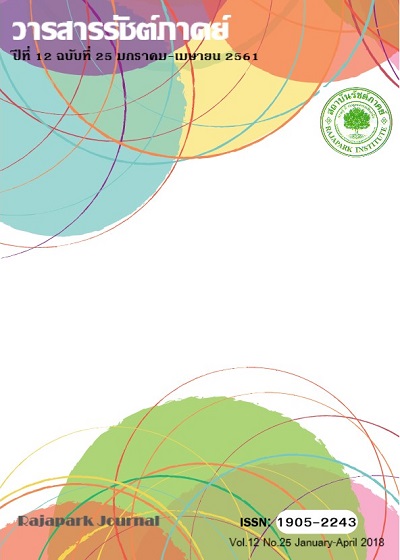Promoting Holistic Health Care of The monks in Lopburi
Main Article Content
Abstract
This research is a qualitative research. The purpose is to study the community context. Current situation and health promotion issues of holistic health of the monks in Lopburi Province and the approach to promoting holistic health care of monks in Lopburi province. The instruments used were interviews, interviews, and observation. The 20 main informants were knowledgeable and involved in research. Five experts were examined. The results showed that a part of the community. The monks were mostly elderly. There is a chronic disease Smoking behavior Drink energy drink When I get sick to buy drugs I had food from alms. Starchy foods are milk, sugar and fat with exercise, walking and cleaning issues, including a lack of outreach activities to educate. Behavior modification and physical activity promotion. The lack of follow-up care visits at the joint between the temple and the agency. Organizations and individuals in the community The Guidelines promote healthcare holistic clergy in Lopburi are six aspects:
Article Details

This work is licensed under a Creative Commons Attribution-NonCommercial-NoDerivatives 4.0 International License.
Views and opinions appearing in the Journal it is the responsibility of the author of the article, and does not constitute the view and responsibility of the editorial team.
References
จาริณี ยศปัญญา และ วันเพ็ญ ศิวารมย์. (2550). การวิจัยการดูแลสุขภาพองค์รวมของพระภิกษุสามเณรในวัดส่งเสริมสุขภาพ. ขอนแก่น: ศูนย์อนามัยที่ 6
เดชา บัวเทศ. (2553). สุขภาพพระสงฆ์ : รูปแบบการดูแลสุขภาพองค์รวมโดยการมีส่วนร่วมของชุมชนในภาคกลางตอนบน.ปริญญาปรัชญาดุษฎีบัณฑิต สาขาวิชาวัฒนธรรมศาสตร์.มหาวิทยาลัยมหาสารคาม
ศุภลักษณ์ ธนธรรมสถิต, ปราณ. ปรียา โคสะสุ และ ศิรดา ศรีโสภา. (2552). สุขภาวะของพระภิกษุสงฆ์ในจังหวัดอุบลราชธานี. สืบค้นจาก http://guideubon.com/news/view.htm
สุรพันธ์ สุวรรณศรี, ทรงคุณ จันทจร และ พระสุทธิสารโสภณ. (2552). การสร้างความสงบสุขในสังคม :การศึกษาแนวทางการบูรณาการกระบวนการเผยแผ่พระพุทธศาสนาและคริสต์ศาสนาในภาคอีสาน. วิทยานิพนธ์ ปร.ด. มหาสารคาม : มหาวิทยาลัยมหาสารคาม.
สุวิมล พลวรรณ. (2552). ปัจจัยที่มีความสัมพันธ์กับคุณภาพชีวิตของพระสงฆ์ที่อาพาธด้วยโรคเรื้อรังจังหวัดสระบุรีประเทศไทย. วิทยานิพนธ์ วท.ม. กรุงเทพฯ : มหาวิทยาลัยมหิดล,
สุภางค์ จันทวานิช. (2551). วิธีการวิจัยเชิงคุณภาพ (พิมพ์ครั้งที่ 8). กรุงเทพมหานคร: จุฬาลงกรณ์มหาวิทยาลัย
พระมหาอุดร สุทฺธิาโณ (เกตุทอง). (2554). ศึกษาสุขภาพแบบองค์รวมวิถีพุทธในพระไตรปิฎก. วิทยานิพนธ์พุทธศาสตรดุษฎีบัณฑิต สาขาวิชาพระพุทธศาสนาบัณฑิตวิทยาลัย. มหาวิทยาลัยมหาจุฬาลงกรณราชวิทยาลัย.
พระไตรปิฎกภาษาไทย, ฉบับมหาจุฬาลงกรณ์ราชวิทยาลัย (2539).
พันธุ์ทิพย์ รามสูตร. (2540). การวิจัยปฏิบัติการอย่างมีส่วนร่วม. กรุงเทพฯ: สถาบันพัฒนาการ. สาธารณสุขอาเซียน มหาวิทยาลัยมหิดล.
รัชยา ภักดีจิตต์. (2555). ธรรมาภิบาลเพื่อการบริหารภาครัฐและเอกชน. กรุงเทพฯ: สำนักพิมพ์แห่ง
สุวัตสัน รักขันโท, อเนก คงขุนทด และสุมาลัย. กาญจนะ. รายงานการวิจัยเรื่อง พฤติกรรมการ. ดูแลสุขภาพตนเองของพระภิกษุในเขตภาคใต้ตอน. บน. ม.ป.ท.; 2551.
สำนักงานหลักประกันสุขภาพแห่งชาติ. (2553). คู่มือปฏิบัติงานกองทุนหลักประกันสุขภาพในระดับท้องถิ่นหรือพื้นที่ (พิมพ์ครั้งที่ 1). กรุงเทพฯ: สำนักงานหลักประกันสุขภาพแห่งชาติ.
อรอุมา เลาหพิบูลย์กุล. (2557). วิธีการบำบัดรักษาสุขภาพเชิงพุทธบูรณาการ. วารสารสถาบันวิจัยญาณสังวร, 5(2), 39-46.
อุทัย สุดสุขและคณะ. (2552). รายงานการวิจัย โครงการศึกษาสถานการณ์ความสามารถในการปฏิบัติกิจวัตรประจำวัน ความต้องการ และคุณภาพชีวิตของผู้สูงอายุ. กรุงเทพฯ : สำนักงานคณะกรรมการวิจัยแห่งชาติ
Ellison, G. C. (1991).Religious involvement and subjective well-being‛, Journal of Health and Social Behavior.Vol. 32 No. 1 (March 1991) : 80-99
Denzin, N. K. (1978). The research act. New York: McGraw-Hill.
Dacha BowLong (2010). Priest Health: A holistic health care model by community participation in the sector.Ph.D. Department of Cultural Studies Mahasarakham University
Jariyanee Panya and Wanpen Sivarom (2007). The holistic health care research of monks and novices in the temple.Health promotion. Khon Kaen: Health Center 6
Lim, Chaeyoon, & Putnam, D.R. (2010). Religion Social Networks and Life Satisfaction. American Sociological Review. 75(6) 914–933
Pender,N.J. (1987). Health promotion in nursing practice. 2 nd ed. New York : Applenton Century. Crofts. Regional Level. Bangkok: National Health Security Office.
Suphakit Thanathatasit, Pran., Preecha Kosasu and Sirada Sripa (2009), The Study of the Monk's Health. In Ubon Ratchathani Province. From http://guideubon.com/news/view.htm
Surapun Suwansri, Khun Chantajorn and Phra Sutthisophon, (2009) Creating Peace in Society : A Study of the Way to Integrate Buddhist and Christian Evangelism in the Northeast.
Suvimol Phonrawan(2009) Factors related to quality of life of monks with chronic diseases in provinces.
Saraburi Thailand. Thesis. Bangkok: Mahidol University,
Supanong Chantavanich. (2008) Qualitative Research Methods. Bangkok: Chulalongkorn University.
A study of holistic health in the Buddhist scriptures in the Tipitaka. Thesis Doctor of Philosophy Faculty of Buddhism, Graduate School. Mahachulalongkorn University Royal College.
Srikantaiah, T.Kanti.& Koenig, Michael E.D. (2002). Knowledge Management for Information Professional. New Jersey: Information Today.
Schwadel, P., & Falci, C. D. (2012). Interactive effects of church attendance and religious tradition on depressive symptoms and positive affect. Society and Mental Health, 2(1), 21-34
Thai Buddhist Scriptures (1996), Mahachulalongkornrajavidyalaya University Dissertation (in Thai). Bangkok: Institute of Development. public health ASEAN University, Mahidol University A study of self-care behaviors of monks in the southern part of Thailand. . 2008.
Uma Laohaipiboonkul (2011). Method of Integrative Buddhist Therapy, Journal of the Buddhist Research Institute. Year 5 Issue 2 (July - December 2557) Page 39-46
Uthai Sudsuk and colleagues (2009). Research Report. A Study of Situational Ability Daily needs and quality of life of the elderly. Bangkok: National Research Council of Thailand.


